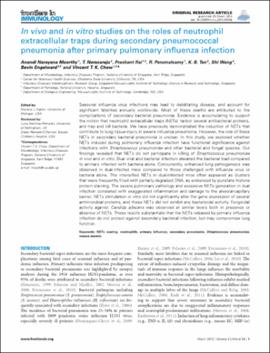| dc.contributor.author | Moorthy, Anandi Narayana | |
| dc.contributor.author | Narasaraju, T. | |
| dc.contributor.author | Rai, Prashant | |
| dc.contributor.author | Perumalsamy, R. | |
| dc.contributor.author | Tan, K. B. | |
| dc.contributor.author | Wang, Shi | |
| dc.contributor.author | Engelward, Bevin | |
| dc.contributor.author | Chow, Vincent T. K. | |
| dc.date.accessioned | 2019-08-28T16:00:50Z | |
| dc.date.available | 2019-08-28T16:00:50Z | |
| dc.date.issued | 2013-03-05 | |
| dc.identifier | oksd_narayanamoorthy_invivoandinvitr_2013 | |
| dc.identifier.citation | Moorthy, A. N., Narasaraju, T., Rai, P., Perumalsamy, R., Tan, K. B., Wang, S., ... Chow, V. T. K. (2013). In vivo and in vitro studies on the roles of neutrophil extracellular traps during secondary pneumococcal pneumonia after primary pulmonary influenza infection. Frontiers in Immunology, 4, Article 56. https://doi.org/10.3389/fimmu.2013.00056 | |
| dc.identifier.uri | https://hdl.handle.net/11244/321376 | |
| dc.description.abstract | Seasonal influenza virus infections may lead to debilitating disease, and account for significant fatalities annually worldwide. Most of these deaths are attributed to the complications of secondary bacterial pneumonia. Evidence is accumulating to support the notion that neutrophil extracellular traps (NETs) harbor several antibacterial proteins, and trap and kill bacteria. We have previously demonstrated the induction of NETs that contribute to lung tissue injury in severe influenza pneumonia. However, the role of these NETs in secondary bacterial pneumonia is unclear. In this study, we explored whether NETs induced during pulmonary influenza infection have functional significance against infections with Streptococcus pneumoniae and other bacterial and fungal species. Our findings revealed that NETs do not participate in killing of Streptococcus pneumoniae in vivo and in vitro. Dual viral and bacterial infection elevated the bacterial load compared to animals infected with bacteria alone. Concurrently, enhanced lung pathogenesis was observed in dual-infected mice compared to those challenged with influenza virus or bacteria alone. The intensified NETs in dual-infected mice often appeared as clusters that were frequently filled with partially degraded DNA, as evidenced by punctate histone protein staining. The severe pulmonary pathology and excessive NETs generation in dual infection correlated with exaggerated inflammation and damage to the alveolar-capillary barrier. NETs stimulation in vitro did not significantly alter the gene expression of several antimicrobial proteins, and these NETs did not exhibit any bactericidal activity. Fungicidal activity against Candida albicans was observed at similar levels both in presence or absence of NETs. These results substantiate that the NETs released by primary influenza infection do not protect against secondary bacterial infection, but may compromise lung function. | |
| dc.format | application/pdf | |
| dc.language | en_US | |
| dc.publisher | Frontiers Media | |
| dc.rights | This material has been previously published. In the Oklahoma State University Library's institutional repository this version is made available through the open access principles and the terms of agreement/consent between the author(s) and the publisher. The permission policy on the use, reproduction or distribution of the material falls under fair use for educational, scholarship, and research purposes. Contact Digital Resources and Discovery Services at lib-dls@okstate.edu or 405-744-9161 for further information. | |
| dc.title | In vivo and in vitro studies on the roles of neutrophil extracellular traps during secondary pneumococcal pneumonia after primary pulmonary influenza infection | |
| osu.filename | oksd_narayanamoorthy_invivoandinvitr_2013.pdf | |
| dc.description.peerreview | Peer reviewed | |
| dc.identifier.doi | 10.3389/fimmu.2013.00056 | |
| dc.description.department | Veterinary Health Sciences | |
| dc.type.genre | Article | |
| dc.type.material | Text | |
| dc.subject.keywords | secondary pneumonia | |
| dc.subject.keywords | streptococcus pneumoniae | |
| dc.subject.keywords | mouse models | |
| dc.subject.keywords | primary influenza | |
| dc.subject.keywords | nets scoring | |
| dc.subject.keywords | neutrophils | |
